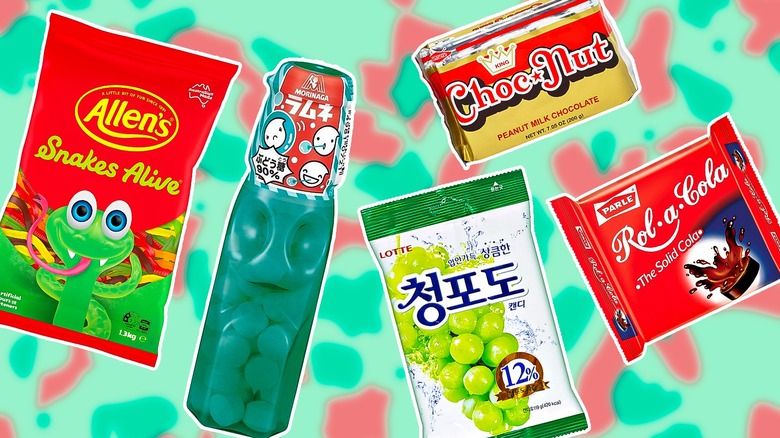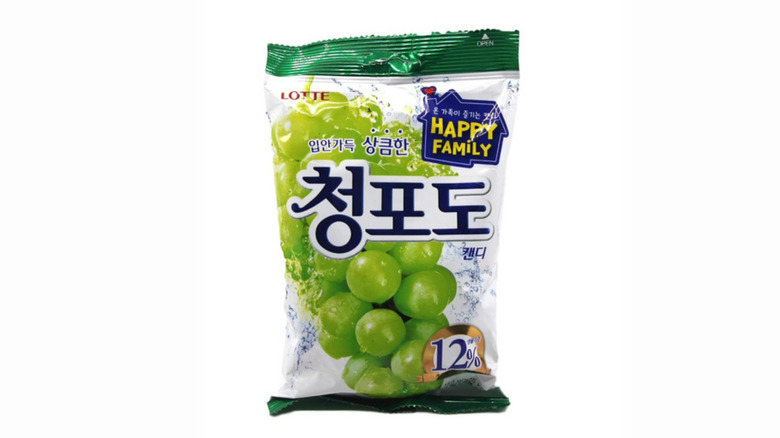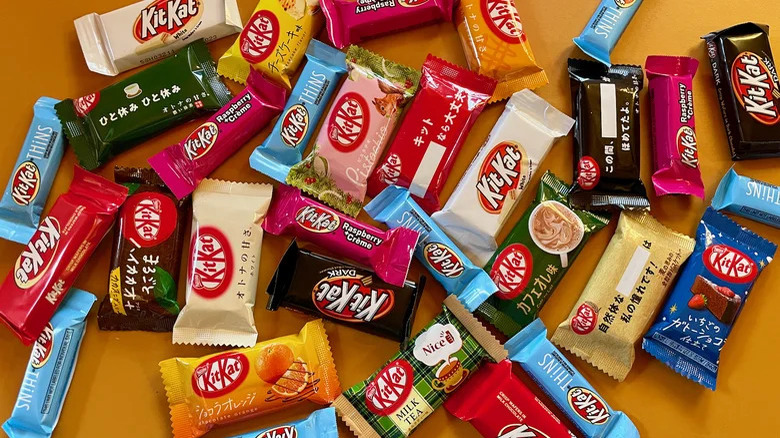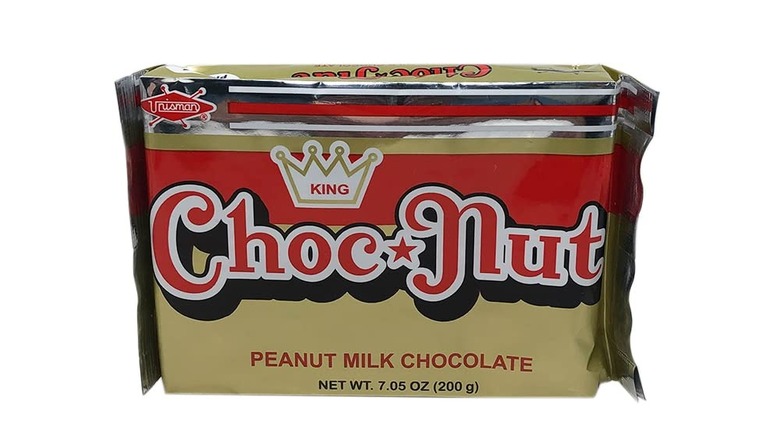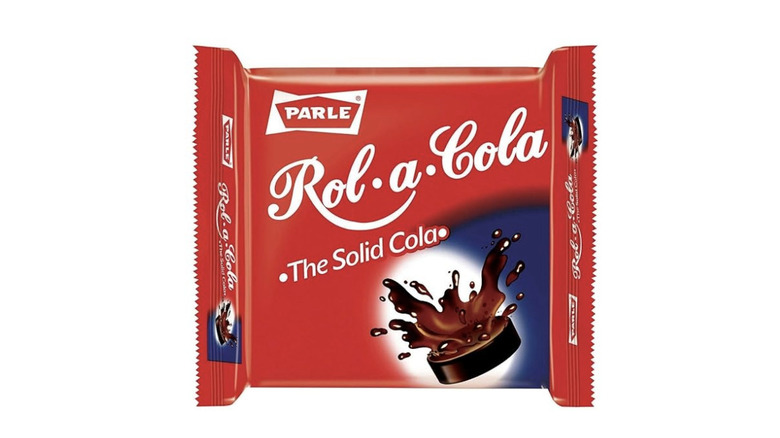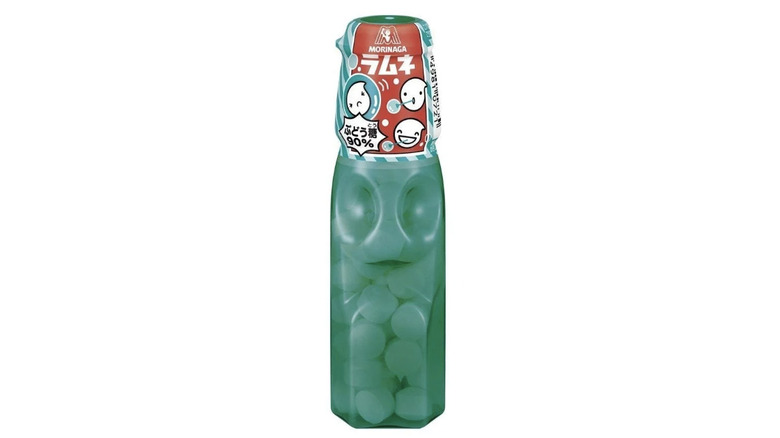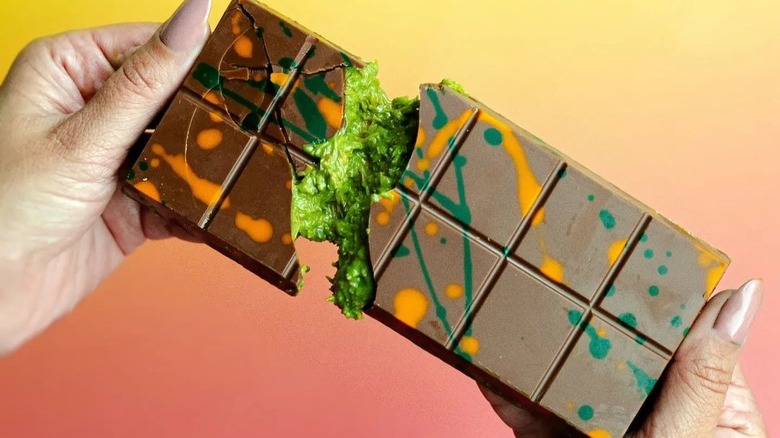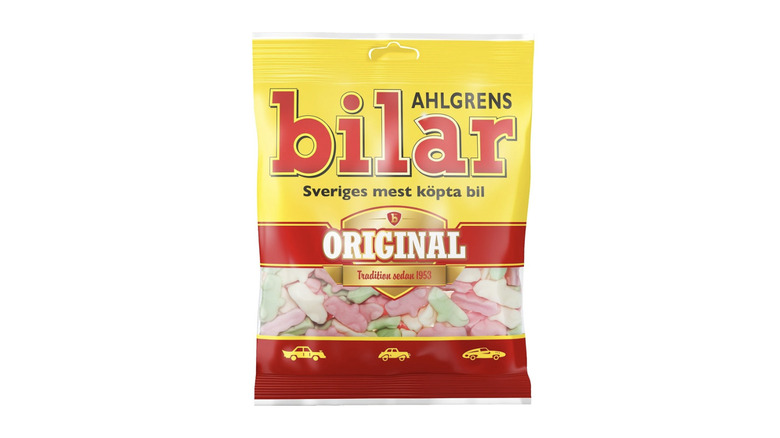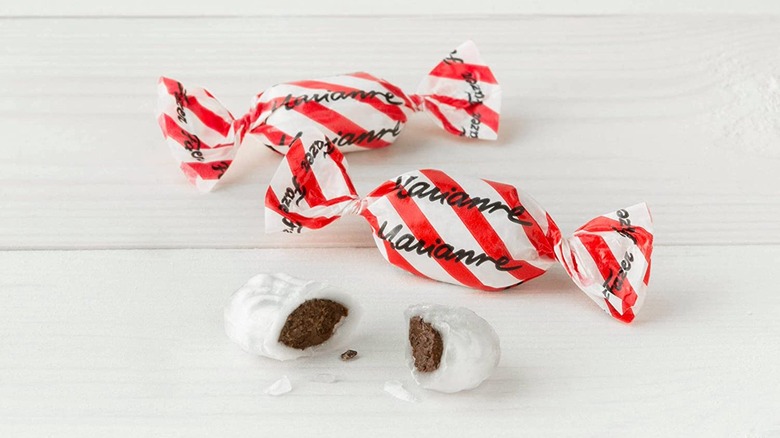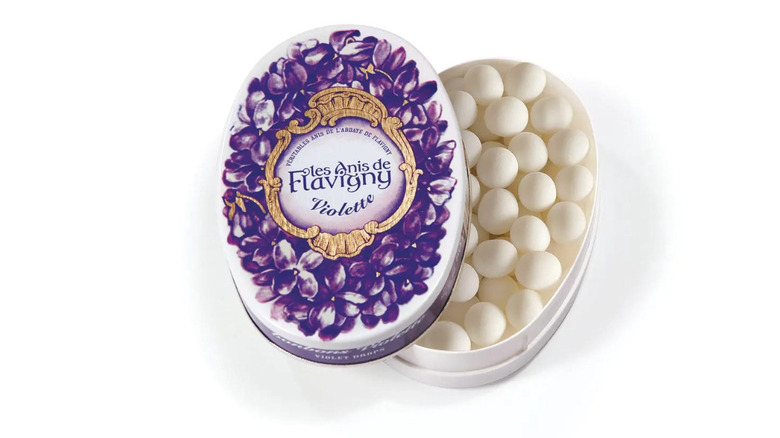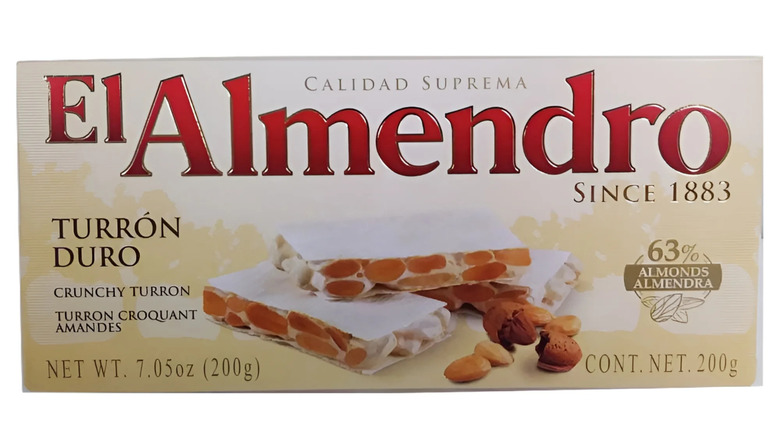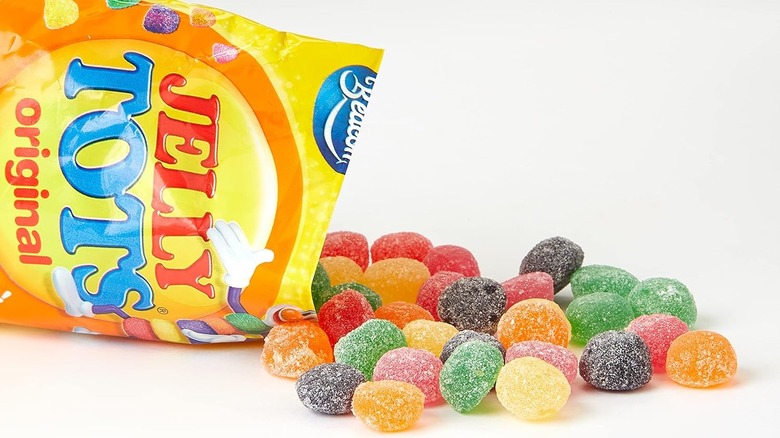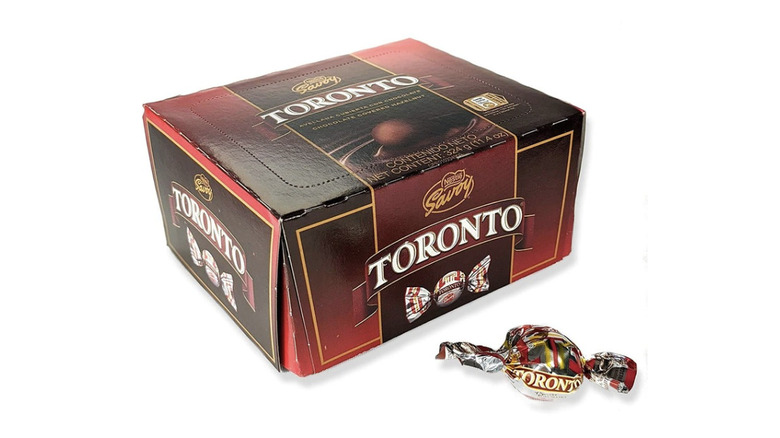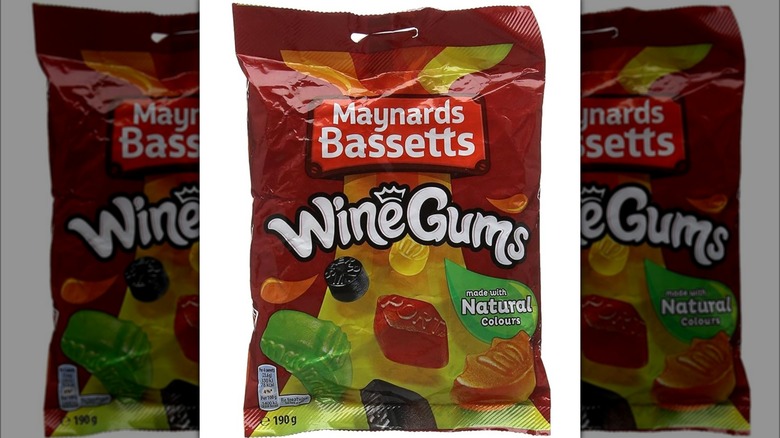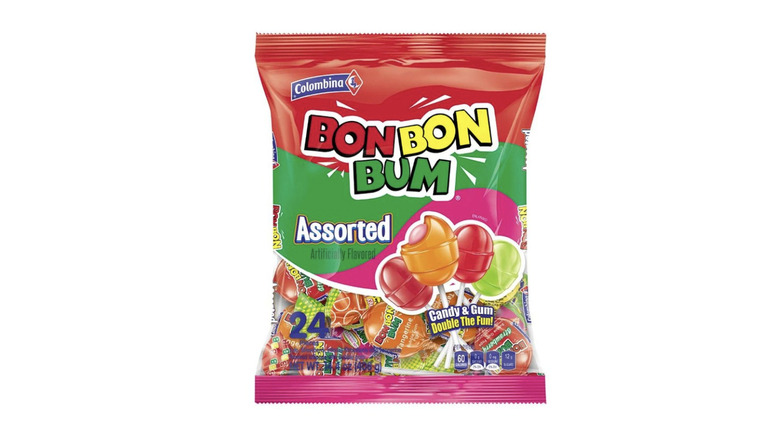15 International Candies We Wish Were In US Stores
Candy is the sweetest wake-up call for your taste buds. When a sugar rush hits your tongue, it's like a spark of saccharine bliss. In 2023, confectionery sales in the U.S. reached a record high of $48 billion, per the National Confectioners Association, and according to its 2024 State of Treating report, sales are projected to reach $61 billion by 2028. Americans clearly have a severe case of the sweet tooth. From chocolates in heart-shaped boxes to the nameless sweets in grandma's glass bowl, candy is an indelible part of everyday life.
Surplus of sugary options aside, there are countries around the world that make candy that's just as tasty and arguably superior to the stuff we have already. For example, Switzerland and Belgium produce some of the best chocolate in the world, hands down. And nothing brings out your inner child like the colorful array of candy you'll find across Asia, or the spicy-sweet confections of Central America. There is no shortage of ways to get your sweet fix, but without a plane ticket or budget for inflated reseller prices, you may find it hard to get your hands on certain candies from across the pond or the Pacific. American candy-philes can always dream, though, so here is a list of international candy flavors we wish we had on store shelves in the U.S.
Lotte's White Grape Cheongdo Candy (South Korea)
In South Korea, Lotte's white grape Cheongdo hard candy is enjoyed by people of all ages. This is a smooth, melt-in-your-mouth candy that you'll find hard to stop eating. If you're unfamiliar with Lotte, the company has hands on everything from food and retail to hotels. Impressive portfolio aside, if the white grape Cheongdo candy were its only product, it'd be more than enough. Each piece is round, bursting with grape flavor, and is individually wrapped to preserve its freshness. Before you know it, you'll have a trash bin filled with discarded wrappers.
White grape Cheongdo candy should be widely available, but sadly, it can only be found in the States at Korean markets and specialty candy shops. If you don't live in a candy-friendly city, you can order the candy online from Amazon, H Mart, or a few other websites. Lotte Cheongdo candy is also available in plum, pineapple, and peach flavors.
KitKat (Japan)
KitKat is considered one of America's most popular candy bars, but for some reason, Japan gets the most unique flavors. From matcha green tea and whole wheat to strawberry and melty caramel, it's enough to make a KitKat lover apply for citizenship. In the States, Hershey runs KitKat, while Nestlé handles all things overseas – that's why we have different flavors state-side and abroad.
Not only are the flavors different, but the recipes are as well. Those who have compared the two say that the chocolate used for the Nestlé version is more high quality compared to the Hershey ones.. Lucky locals of Japan can indulge in seasonal flavors and even alcoholic KitKats. The bottom line is that Japan makes some of the best KitKat flavors that we wish we had in the States.
King Chocnut Milk Chocolate (Philippines)
King Chocnut milk chocolate is a Filipino candy bar that deserves a permanent spot on American store shelves. It has a rich milk chocolate and peanutty taste with a powdery, crumbly texture that melts in your mouth. Though it's been popular since the 1970s, international demand has risen thanks to an increasing number of Filipinos living abroad. Despite its growing global footprint, King Chocnut remains Filipino-owned.
It's not as easy to find in the States as other candies on this list, either. If you live in a city with a Filipino community, you may be able to locate some at a market. If not, you'll have to try your luck online. Walmart has some in stock, though Amazon and eBay look to be even better options for finding this candy. You can try to ask a friend or family member visiting the Philippines to pack some in their bags to take home for you.
Rol-a-Cola (India)
Rol-a-Cola is a soda-flavored candy that we wish we had in the U.S. This candy's taste is nearly-identical to real cola — and it's a sugar lover's dream. In India, this soda-inspired sweet is a staple childhood treat enjoyed well into adulthood. Rol-a-Cola is currently manufactured by Parle Products, one of India's top confection brands. The candy has undergone a massive resurgence in India in the last few years after being discontinued by Parle in 2006.
The response to Parle's #BringRolaColaBack campaign exceeded expectations, proving that nostalgic flavors can stand the test of time. Sadly, that resurgence hasn't reached American shores. It looks like eBay is the easiest way to have some shipped to your door. If it were up to us, though, Parle's next campaign would be #BringRolaToAmerica.
Allen's Snakes Alive (Australia)
Australia is home to all sorts of venomous snakes, but fortunately, Allen's Snakes Alive gummies won't send you to the hospital. Overindulging in these snaky sweets might give you a tummy ache, though. Stretchy, twisty, and fruity, Snakes Alive is Australia's version of gummy worms, or better yet, an improved version of Haribo's Twin Snakes. It's made by Allen's, a confection brand owned by Nestlé Australia. Its flavors include lemon, strawberry, blackberry, pineapple, and apricot. There are sour snakes and multi-flavored versions called Killer Pythons.
Like many of the other international candies on this list, Snakes Alive can only be found in specialty candy shops, on Amazon, or on Australian food websites. If you're into Australian-made edible reptiles with a fruity flavor, chewy consistency, and zero artificial colors, you'll wish we had Allen's Snakes Alive in the U.S., too.
Ramune Soda Candy (Japan)
Ramune soda candy is further proof of Japan's incredible talent for candy making. This fizzy-flavored favorite was inspired by the country's most popular soda, ramune. It has Coca-Cola-level fame in Japan and comes in a marble-sealed glass bottle that's just as worthy of Warhol treatment. In Japan, the ramune soda craze inspired an entire subcategory of soda-flavored candies, some of which are sold in plastic versions of the iconic bottle. Though it translates to "lemonade" in English, ramune soda (and the candies that were inspired by it) taste closer to citrusy bubble gum.
This bubbly beverage has been easy to find in America for some time, but the candy is a bit trickier. You can find ramune candies at Japanese markets, but if you live in a city without any and don't mind waiting for overseas shipping, Amazon can come through in a candy pinch. We have our fingers crossed that one day, ramune soda candy will officially bubble up in the U.S.
Can't Get Knafeh Of It (United Arab Emirates)
If this list were titled "the best names for candy," Dubai's viral chocolate bar "Can't Get Knafeh Of It" would be number one. Created by Fix Dessert Chocolatier, this candy is comprised of a thick slab of milk chocolate loaded with crispy knafeh (a traditional Middle Eastern dessert), pistachios, and a tahini spread. Knafeh consists of shredded phyllo dough and cheese infused with a syrup. And that's just the tip of the sweet-berg. Between the layers of this time-tested pastry is a delectable blend of nuts, dried fruit, and clotted cream. What do you get when you pair that with milk chocolate? Pure saccharine bliss.
Ever since the "Can't Get Knafeh Of It" hit the interwebs, candy lovers have been on the hunt for it. Fake versions have even popped up on Amazon for nearly $40 per bar. The biggest difference between this viral sweet-sation and others on this list is that it isn't made by a major company. You can only get the real deal from the Fix Dessert's online store, or you'll need to try your hand at recreating it at home.
Ahlgrens Bilar Original (Sweden)
If you think that Volvo or Volkswagen are the best-selling car brands in Sweden, think again. According to the tagline of the uber-famous candy, Ahlgrens Bilar Original, this candy is, in fact, the country's best-selling car. Cheeky slogans aside, it's a car-shaped candy that has been taking Scandinavian sweet tooths for a spin since 1953. The word "bilar" literally means "car" in Swedish. When it comes to popular Swedish candies, Ahlgrens Bilar Original is one of the best and would prove to be a wonderful addition to American candy aisles.
The candies have a light fruity, anise-like flavor and chewy, marshmallow-like consistency that's stretchy but doesn't tear easily. Each pack features three colors: white, green, and pink. If you're into black licorice or herbal-flavored sweets, you'll love these edible automobiles.
Fazer Marianne (Finland)
Everything about Finland's Fazer Marianne mint candy is perfection. It comes in an elegant red-and-white striped wrapper that unravels to reveal a crunchy peppermint shell filled with decadent milk chocolate. It's refreshingly sweet like a peppermint patty, but it has a bit of bite. Fazer Marianne's Christmas-y colors has made it especially popular in Finland during the holidays, though people enjoy them as after-dinner mints year-round, too.
Americans would fall in love with Fazer's candy, but unfortunately, you can't find it as easily as others on this list. Not unless you're ready to shell out some ridiculous dough. Walmart has a 7.76-ounce pack on its website for almost $20 (not including shipping). Even Amazon charges close to $30 for the same size package. That said, there's nothing wrong with splurging on sweets every now and again.
Les Anis De Flavigny Anise Drops (France)
France is also known to dabble in anise-infused sweets. Les Anis De Flavigny, or "The Anise of Flavigny," is one of the oldest candies on this list. It was first introduced in 1591 and is not your everyday store-bought treat. Even today, only three or four ingredients are used to make it: green anise seed, beet sugar, and extracts.
Now you can experience this morsel of French history in flavors like rose, black currant, lemon, orange blossom, ginger, mandarin, and more. But, not here in the States. Luckily, the ever-reliable Amazon has various flavors in bulk bags for less than $30. We, however, think it's high time we give anise lovers in America an official taste of what's been dubbed "the French mint."
El Almendro Turrón (Spain)
Another old-world candy with lasting power is Spain's El Almendro turrón. The brand has been selling turrón, which is a traditional Spanish nougat candy, since the late 1800s. Sweet, nutty, and toothsome, turrón can vary in flavor depending on its ingredients. El Almendro offers two classic varieties of the candy: turrón duro (hard) and turrón blando (soft). The former is made with honey and roasted almonds while the other uses roasted ground almonds for a more delicate consistency. Both are highly popular around Christmastime.
Turrón is an authentic Spanish dessert that you need to try. It's sad that you're only likely to find El Almendro turrón in Spanish markets. Besides that, you'll have to buy it from online retailers like Amazon, Walmart, and a few sites that specialize in Spanish products.
Beacon's Jelly Tots Original (South Africa)
When it comes to countries known for candy, South Africa doesn't get enough credit. The region knows a thing or two about quality sweets. Beacon's Jelly Tots are like the country's version of Dots — the chewy, bite-sized, and fruit-flavored candy we enjoy in the United States. This South African version of a childhood classic has been putting smiles on faces for over 50 years.
These candies are vegan-friendly and come in lemon, lime, tutti-frutti, and orange flavors. Beyond fruity Tots, Beacon makes chocolate-covered, speckled egg, sour, and other flavors of Tots candy as well. The sheer variety makes this tasty South African candy brand a contender for shelf space here in the U.S.
Nestlé Toronto (Venezuela)
Don't be fooled by the name, Nestle's Toronto candy does not hail from Canada. It's a mouthwatering chocolate-covered hazelnut bonbon created in Venezuela. Toronto chocolate hit the scene in 1949 and quickly established itself as one of Venezuela's best and most ubiquitous candies. It's safe to say that the candy is extremely popular there. Toronto chocolate is not only enjoyed as a sweet treat; it's also an integral part of the country's social fabric.
One time, Venezuela even had a president nicknamed "The Toronto President," who was known to frequently carry the bon bons in his pocket. Candy that is this legendary deserves an American audience. Like all the best international candies, though, Americans will have to call up their local confectionery shop or buy online from Amazon, Walmart, Amigo Foods, and similar sites.
Maynards Wine Gums (English)
Maynards, which was introduced to London in 1909, is a beloved English candy brand that transforms adult beverages into bite-sized, snackable treats ... kinda. Although its name suggests otherwise, the candies do not actually contain alcohol, and despite having names like gin, sherry, Bordeaux, and Champagne, do not taste like wine either. But, these toothsome treats can still give you a sugary buzz.
They have a strong fruity, smooth flavor with a chewy texture that's tougher than American-style gummies. Maynards Wine Gums have made it as close as Canada, but for some reason, have yet to make it south of the border. As much as we love Haribo, this English take on a classic chewy confection is the shake-up our candy aisles need.
Bon Bon Bum Lollipops (Colombia)
Colombia is another South American country known for producing quality sweets. From the chewy caramel and coconut-infused Supercoco and Leche Condensada Tubito (or condensed milk in a tube) to the caffeinated kick of Coffee Delight, there's something for every palate. Bon Bon Bum lollipops were made for lovers of fruity candies who are looking to take their sugar high to new heights. These pops are one of Colombia's favorite candies and have been around for more than 50 years.
Bon Bon Bum lollipops come in a wide range of flavors, too. There are tropical flavors like passion fruit and watermelon and assorted packs with flavors like strawberry and tangerine. Bon Bon Bums were available in 90 countries as of 2018. Fast forward to 2024, and there's still no reason why we can't have this, clearly popular, international candy available on U.S. shelves.
